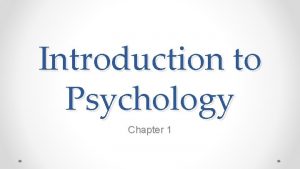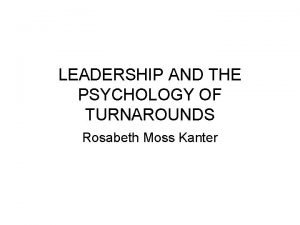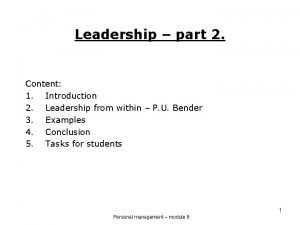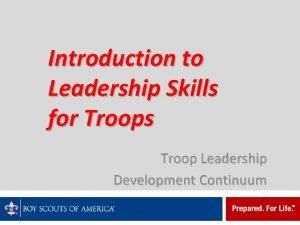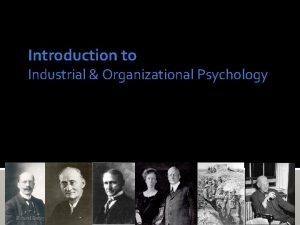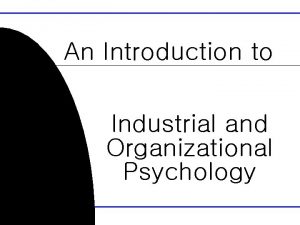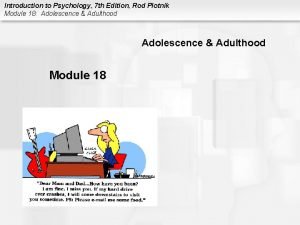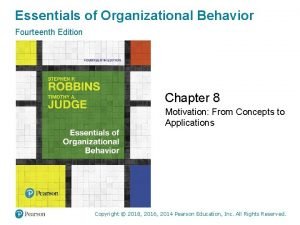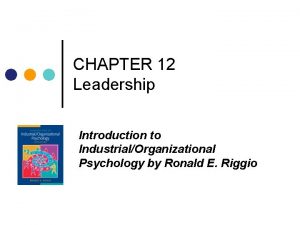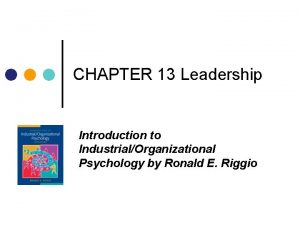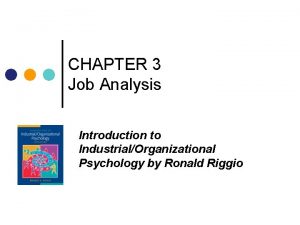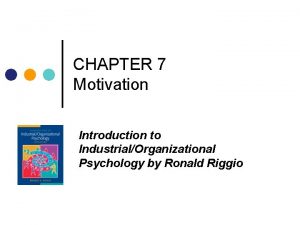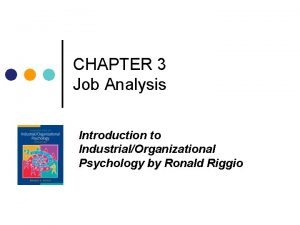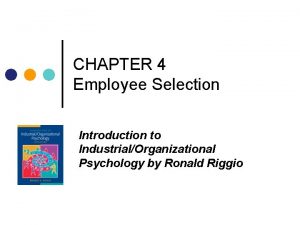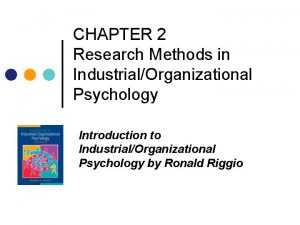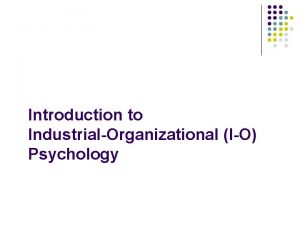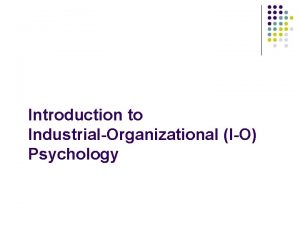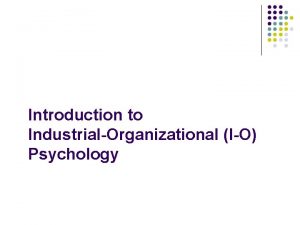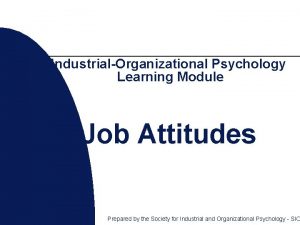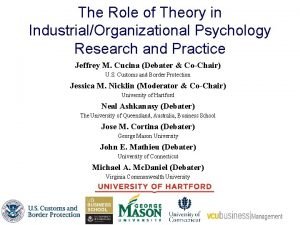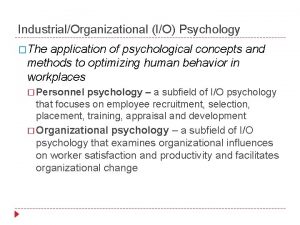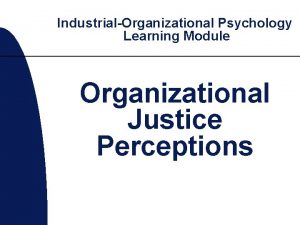CHAPTER 13 Leadership Introduction to IndustrialOrganizational Psychology What


































- Slides: 34

CHAPTER 13 Leadership Introduction to Industrial/Organizational Psychology

What is Leadership? Leadership is the ability to guide a group toward the achievement of goals. ◦ Leaders can be formally recognized by the organization, or individuals can emerge as informal leaders within work groups because they have some characteristic that the group members value. ◦ Not all managers are leaders What is the problem for psychological studies concerning leadership issues?

Universalist Theories of Leadership Universalist theories look for the major characteristics common to all effective leaders. ◦ Great man/woman theory maintains that great leaders are born, not made. ◦ Trait theory attempts to discover the traits shared by all effective leaders. ◦ Traits are enduring attributes associated with an individual’s personality or physical makeup.

Universalist Theories of Leadership ◦ Research indicates that extraversion, conscientiousness, openness to experience, agreeableness, and emotional stability, in combination, are associated with effective leadership (Bono and Judge, 2004). ◦ Possession of flexibility, charisma, and social intelligence are also important for leadership (Riggio, 1986). ◦ The major problem with the original trait approach is that it was too general.

Behavioral Theories of Leadership Behavioral leadership theories (derived from Ohio State and University of Michigan studies) focus on the behaviors common to effective leaders. ◦ The Ohio State Leadership Studies identified two important leader behaviors through factor analysis: Initiating structure (defining, organizing, structuring the work situation). Consideration (showing concern for feelings and needs of followers). Distinct categories – don’t necessarily coexist IS productivity C JS Recent studies both IS and C to different extents

Behavioral Theories of Leadership ◦ The University of Michigan Leadership Studies also identified two important leader behaviors. In task-orientated behaviors, leader behaviors focused on the work task. In relationship-oriented behaviors, leader behaviors focused on maintaining interpersonal relationships on the job. ◦ Both types of behaviors have been linked to effective leadership. ◦ The difference from Ohio studies R-O were seen as more effective ◦ Followers of R-O leaders more satisfied although both are related to work group performance

The Leadership Grid: The Marketing of Leadership Theory 9. 9. 1. 9. Team management Country club management 5. Middle of the road management 9. 1. Authority compliance management

Contingency Theories of Leadership 1. Fiedler’s contingency model maintains that effective leadership depends on a match between the leader’s style and the degree to which the work situation gives control and influence to the leader. The first step: ◦ According to Fiedler, leaders may be primarily task-oriented, or primarily relationship-oriented. ◦ How are we gonna identify them?

Contingency Theories of Leadership ◦ To assess leaders’ task or relationship orientation, leaders use the Least Preferred Coworker (LPC) scale to rate their most difficult follower. Persons who give their least preferred coworkers very harsh ratings (low LPC scores) are task-oriented leaders. Persons who rate their least preferred coworker somewhat leniently (higher LPC scores) are considered to be relationshiporiented.


Contingency Theories of Leadership ◦ In Fiedler’s model, to assess the work situation, three variables are examined. Leader-member relations refers to the quality of the relationship between leader and followers’ loyalty for and acceptance of the leader. Task structure is an assessment of how well elements of the work task are structured whether the output can easily be evaluated, the group has well-defined goals, clear procedures for achieving these goals exist. Position power is a leader’s authority to punish or reward ability to hire, fire, discipline, and reward.

Contingency Theories of Leadership ◦ According to Fiedler, task-oriented leaders are successful in very unfavorable situations (where leader-member relations are poor, the task is unstructured, and the leader has weak position power) because of their take-charge style. ◦ Task-oriented leaders are also effective in very favorable situations because they encourage high productivity. ◦ Relationship-oriented leaders are most effective when their situational control and influence are neither very high nor low.


Contingency Theories of Leadership The path-goal theory states that a leader’s job is to help the work group achieve their desired goals, using one of four categories of behavior. Directive behavior provides instructions and suggestions for job performance. Achievement-oriented behavior concentrates on particular work outcomes. Supportive behavior shows concern for workers’ well-being. Participative behavior encourages members to assume active roles in planning and decision making.

Basic Idea

Path-Goal Theory Matrix

Contingency Theories of Leadership The Decision-making model is a theory that matches characteristics of the situation with leader decisionmaking strategies. ◦ The theory provides different decisionmaking strategies. ◦ The theory predicts proper leader behavior in making decisions and gives “prescriptions” for the decision maker to follow.



Contingency Theories of Leadership The leader-member exchange model (LMX theory) asserts that effective leadership is determined by the quality of the interaction between leaders and particular group members. ◦ Leader-member exchange can range from low quality to high quality. ◦ With high quality leader-member exchange, there is frequent, positive communication between leaders and members.

In-Group & Out-Group Subordinates v. In-Group S S Out-Group In-Group S Leader S S S S – more information, influence, confidence & concern from Leader – more dependable, highly involved & communicative than out-group Subordinate S S S v Out-Group – less compatible with Leader – usually just come to work, do their job & go home

Charismatic and Transformational Leadership Theories Charismatic leadership theory states that leaders possess some exceptional characteristics that cause followers to be loyal and inspired. ◦ Charismatic leaders communicate shared group goals and convey confidence in their own abilities and those of followers. ◦ Charismatic leaders are most effective when goals are unclear and situational conditions are unstable. ◦ Some researchers suggest that charismatic leaders possess exceptionally high-quality social skills and an ability to inspire followers at a deep emotional level (Riggio, 1987).

Charismatic and Transformational Leadership Theories Transformational leadership focuses on the leader’s ability to provide shared values and a vision for the future of the work group. ◦ There are four components of transformational leadership. Idealized influence: the transformational leader is a positive role model. Inspirational motivation: the leader inspires followers by providing a compelling vision of a positive future. Intellectual stimulation: followers’ curiosity and creativity are stimulated and challenged. Individualized consideration: the leader pays personal attention to each member’s needs and concerns.


PL Theory as An Example of Culture -Specific Leadership Theories Paternalistic leaders Those who form a hierarchical relationship in which the role of the leader is to provide care, protection and guidance in work and non-work areas of employees’ lives in exchange for employees’ loyalty and deference towards the leader (Aycan, 2006). Five Dimensions of PL (Aycan, 2006): Family atmosphere at workplace Individualized relationships with subordinates Involve in non-work lives of subordinates Loyalty expectation Status hierarchy and authority

The Self-Concept Based Motivational Theory of Charismatic Leadership (Shamir, House & Arthur, 1993) Transformational leaders. . . give positive references to the subordinates’ self-efficacy and worth, encourage and motivate them for engaging in challenging tasks, and contribute to their self-development. increase the salience of collective identity and enhance internalization of the values of the leader and the organization. Theory of Paternalistic Leadership (Aycan, 2006) Paternalistic leaders. . . engage in empowering supervision as a way to fulfilling their obligation towards employees. create a family atmosphere in the workplace. expect subordinates to accept the leader’s values and norms and internalize them. Both transformational and paternalistic leaders show high level of support, care and consideration.

Mediating Processes: Extrinsic Motivational States Transformational leaders. . . communicate that OCBs are instrumental for gaining tangible and intangible rewards. improve the teamwork climate in which employees feel responsibility towards the group and share a mission. increase employees’ desire to show their commitment to the group, the organization and the leader. Paternalistic leaders. . . expect loyalty and deference from their subordinates. emphasize the importance of formation and protection of the family atmosphere in the work place. increase employees’ desire to avoid criticisms from the leader to protect the caring and nurturing relationship with the leader.

SOCIAL IDENTITY THEORY OF LEADERSHIP Leadership A broad area of research in social psychology, as well as in other disciplines such as industrial and organizational psychology, sociology, and management. In more recent conceptualizations Leadership A dyadic process which is directed by not only leaders’ but also followers’ cognitions and behaviors. The role of followership as inputs rather than outputs of leadership process. Social identity theory of leadership A spin-off of social identity theory (SIT; Tajfel & Turner, 1979) and self-categorization theory (SCT; Turner, 1985; Turner, Hogg, Oakes, Reicher, & Wetherell, 1987)… Emphasizes the dyadic and group identification -based nature of leadership (Hogg, 1996)

SOCIAL IDENTITY THEORY OF LEADERSHIP The basic proposition of SIT of leadership Followers are likely to endorse and support individuals who represent the group identity, which is defined by specific values and norms differentiating the in-group from out-groups, as their leaders (Hogg & Hains, 1996). Followers who are more identified with their groups than others More sensitive to others’ representativeness or prototypicality of the given group. Followers’ social identification level would moderate the relationship between leader group prototypicality and endorsement of the leader (Hogg, 2001; Hogg & van Knippenberg, 2003; Lord & Brown, 2004; van Knippenberg, De Cremer, & Hogg, 2004). Contextual variables that affect perceived prototypicality of a leader in specific groups… Group or work context, Leadership style or behavioral pattern, Follower dispositions and motivations.

Follower Outcomes of Leader Group Prototypicality Leader group prototypicality… ◦ Leadership endorsement and perceived leadership effectiveness (e. g. , Hains et al. , 1997; Fielding & Hogg, 1997; Hogg et al. , 1998; Hogg et al. , 2006) ◦ Perceived fairness in in-group contexts (e. g. , Haslam & Platow, 2001 a, 2001 b; Platow, Mills, & Morrison, 2000; Platow & van Knippenberg, 2001) ◦ Trust in leader (e. g. , van Knippenberg, De Cremer, & van Knippenberg, 2007) ◦ Perceived procedural fairness (e. g. , van Dijke & De Cremer, 2008) ◦ Cooperation with the leader (e. g. , De Cremer & van Vugt, 2002) ◦ Job satisfaction (e. g. , Cicero et al. , 2007; Pierro et al. , 2005; Pierro et al. , 2009) ◦ Creative effort and performance (Hirst et al. , 2009)

Applications of Leadership Theories According to the various theories of leadership you learned up to now, classify the above specified leaders: Hitler Kennedy Gandhi Usame bin Ladin Sakip Sabanci Princess Diana

Applications of Leadership Theories According to the various theories of leadership you learned up to now, classify the above specified leaders: Suleyman Demirel Evita Turgut Ozal Obama Ataturk Recep Tayyip Erdogan Kemal Kilicdaroglu

Applications of Leadership Theories Leadership training can follow two general approaches. ◦ Teaching leaders diagnostic skills for assessing situations to determine types of leader behaviors that work best. ◦ Teaching leaders specific skills or behaviors that they lack. ◦ A combination of both approaches is likely to be most effective.

Applications of Leadership Theories Research in redesigning jobs indicates that leaders may be unnecessary in certain instances, leading to a search for “substitutes for leadership”. This applies to: ◦ Job enrichment groups. ◦ Groups where all members have equal status and high skills/abilities. ◦ Work tasks that are well-structured and intrinsically satisfying to workers. ◦ Shared leadership, where leadership is shared among the group members rather than being centralized in one person.
 Group polarization.
Group polarization. Transformational vs transformative leadership
Transformational vs transformative leadership What is adaptive leadership style
What is adaptive leadership style Capable but cautious performer
Capable but cautious performer Introduction to psychology chapter 1
Introduction to psychology chapter 1 Introduction to psychology chapter 1
Introduction to psychology chapter 1 Introduction to psychology chapter 1
Introduction to psychology chapter 1 Chapter 1 introduction to psychology
Chapter 1 introduction to psychology Leadership and the psychology of turnarounds
Leadership and the psychology of turnarounds Positive psychology ap psychology definition
Positive psychology ap psychology definition Social psychology ap psychology
Social psychology ap psychology Scope of psychology
Scope of psychology Social psychology definition psychology
Social psychology definition psychology Health psychology definition ap psychology
Health psychology definition ap psychology Introduction to leadership
Introduction to leadership Introduction to leadership skills for troops
Introduction to leadership skills for troops L 101 lesson 2
L 101 lesson 2 Introduction to leadership
Introduction to leadership Siop jobnet
Siop jobnet Anthropology psychology and sociology
Anthropology psychology and sociology Introduction to industrial psychology
Introduction to industrial psychology Health psychology definition
Health psychology definition Introduction to forensic psychology bartol pdf
Introduction to forensic psychology bartol pdf Sociology and anthropology venn diagram
Sociology and anthropology venn diagram Introducción a la psicología psychology: an introduction
Introducción a la psicología psychology: an introduction Introduction to psychology lecture
Introduction to psychology lecture Introduction to psychology rod plotnik
Introduction to psychology rod plotnik What is anthropology
What is anthropology Ib psychology ia example
Ib psychology ia example Unit 1 introduction to psychology
Unit 1 introduction to psychology Unit 1 introduction to psychology
Unit 1 introduction to psychology Lumen introduction to psychology
Lumen introduction to psychology Organizational behavior chapter 12
Organizational behavior chapter 12 Lord of the flies chapter 8
Lord of the flies chapter 8 Chapter 8 organizational leadership
Chapter 8 organizational leadership




